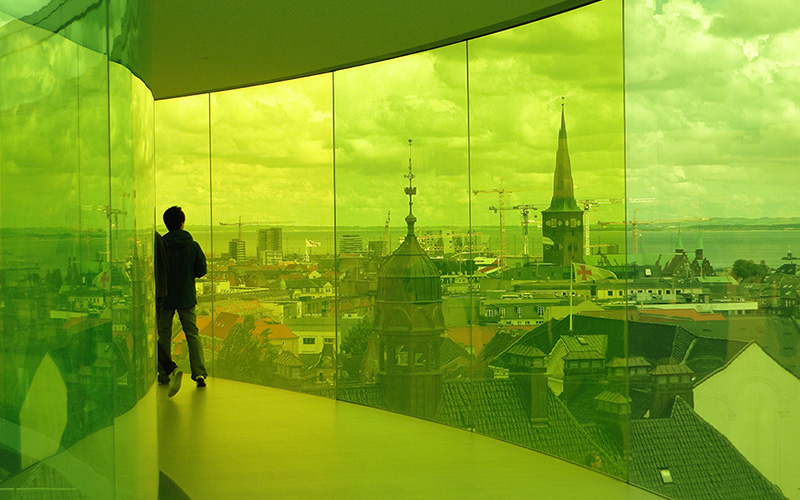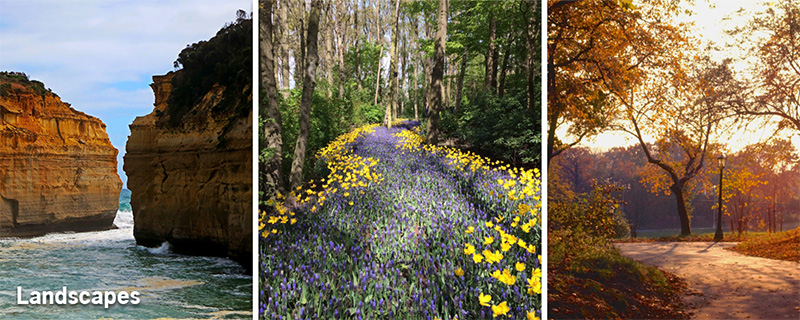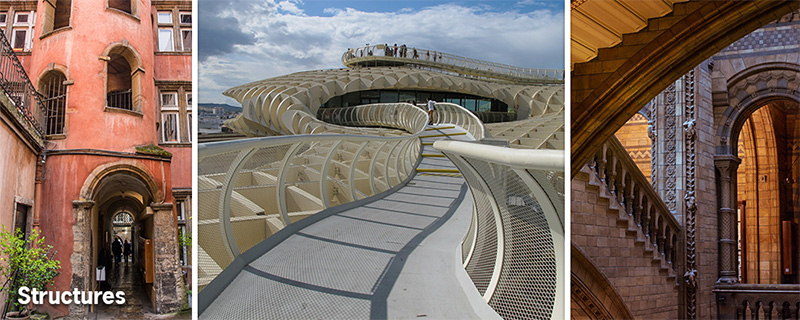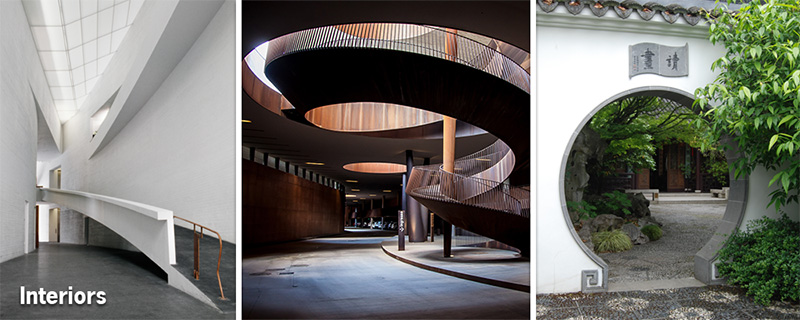This feeling of excitement is exactly what the biophilic pattern of “Mystery” replicates in our built environment.
Pattern 13: Mystery
Mystery is part of the “Nature of the Space” category of biophilic patterns. Instead of bringing elements of nature directly into the space (Nature in the Space), or mimicking natural patterns, materials and forms (Natural Analogues), Nature of the Space patterns replicate enjoyable or exciting spatial conditions found in nature.

Image via Wikimedia Commons
The Mystery pattern is defined as the promise of more information achieved through partially obscured views or other sensory devices that entice the individual to travel deeper into the environment. A space with a good Mystery condition has a palpable sense of anticipation, or of being teased, offering the senses a kind of denial and reward that compels one to further investigate the space. A Mystery condition does not feel like a “don’t-open-that-door horror movie moment” (i.e., surprising, unpleasant, dangerous). Rather, it slowly reveals a new condition, feature, or information.
Origins
Mystery, like many of the biophilic patterns, is not an alien concept to designers. Particularly in landscape architecture, the “denial-reward approach” technique has been used in many a beloved park, garden, and building entrance. Famous examples include the gardens at the Katsura Imperial Villa in Kyoto, Japan, and Frederick Law Olmsted’s Prospect Park in Brooklyn, New York. Both examples employ curving pathways, rolling hills, and trees to partially obscure buildings or vistas that lay beyond, encouraging visitors to explore the landscape.

Left image and middle images creative common zero, right image copyright Ed Yourdon/Flickr.
Environmental psychologists have found that Mystery conditions engender a strong pleasure response within the brain that may be a similar mechanism to that of anticipation in that we are guessing what may be around the corner. Mystery conditions typically improve preference for a space, heighten curiosity, increase interest in gaining more information, and enhance other biophilic conditions.
Applying Mystery to architecture and interior spaces
Although much of the research and practice of using Mystery in design centers around landscapes, its universal attributes can be applied to architecture and interiors.
So what makes a space “mysterious”? Spatial qualities and planning strategies that reveal more information as users explore the space are particularly good at creating a Mystery condition. Designers can use curving hallways, partially obscured artwork, partially obscured movement, muffled sound, variable transparencies or peek-a-boo windows, and light and shadow.
Mystery is unique among the Nature of the Space patterns because the designer must conceive of how a person might experience a progression of spaces rather than how they might experience a single space.

All images Creative Commons Zero
People need to move to experience Mystery. So designers must consider how users approach a significant object, what sensory experiences will entice them to enter a space, and what spatial characteristics will encourage them to continue down a path or hallway.
Spaces with regularly returning occupants such as workplaces, residences or schools have the challenge of habituation: Mystery has diminishing returns. If you know the artwork that sits at the end of the hallway because you walk that hallway everyday, you’re less likely to be intrigued by the Mystery condition. In such spaces, interventions that are unpredictable or that change over time may work best. For example, changes in light and shadow, sound sourcing, information content, and activity over time, whether throughout a day or over years, can keep occupants engaged and curious.
Avoiding “horror movie” moments
Many people might find a door with a “do not enter” sign enticing and perhaps mysterious. However, that’s not a Mystery condition because there is no hint of what lies beyond the door.

Left image copyright Museum of Contemporary Art Kiasma/Flickr, middle image copyright Tom Godber/Flickr, right image courtesy of Bill Browning.
Any feature that surprises, is fear-inducing or perceived as risky is not preferred. In interior spaces, these can be items such as sharp corner, acoustics that completely deaden sound, closed doors, or completely obscured objects until you happen upon them (surprise). Conversely, objects that are fully exposed loose all sense of enticement. Always reveal a little information, but not too much!
Another tool in the biophilia toolkit
Whether you’re hiking outdoors, strolling through gardens, or listening to sounds of a good party around a corner, Mystery makes for an exciting experience. Verified by research, Mystery evokes a strong pleasure response that designers have used intuitively for centuries to create enticing conditions.
Since Mystery relies on a progression of spaces or conditions, it can be strategically implemented to enhance other biophilic patterns through tantalizing approaches or by drawing them to a desired intervention. With a little creativity in its use, Mystery can be a powerful mechanism for improving occupant experience.
References
- Biederman, I. & E. Vessel (2006). Perceptual Pleasure & the Brain. American Scientist, 94(1), 249-255.
- Blood, A., & R.J. Zatorre (2001). Intensely Pleasurable Responses to Music Correlate with Activity in Brain Regions. Proceedings from the National Academy of Sciences, 98 (20), 11818-11823.
- Ikemi, M. (2005). The Effects of Mystery on Preference for Residential Façades. Journal of Environmental Psychology, 25, 167–173.
- Herzog, T.R. & A.G. Bryce (2007). Mystery and Preference in Within-Forest Settings. Environment and Behavior, 39 (6), 779-796. 97
- Herzog, T.R. & L.S. Kropscott (2004). Legibility, Mystery, and Visual Access as Predictors of Preference and Perceived Danger in Forest Settings without Pathways. Environment and Behavior, 36, 659-677.
- Nasar, J.L. & B. Fisher (1993). ‘Hot Spots’ of Fear and Crime: A Multi-Method Investigation. Journal of Environmental Psychology, 13, 187-206.
- Salimpoor, V.N., M. Benovoy, K. Larcher, A. Dagher, & R. J. Zatorre (2011). Anatomically Distinct Dopamine Release During Anticipation and Experience of Peak Emotion to Music. Nature Neuroscience, 14 (2), 257-264.